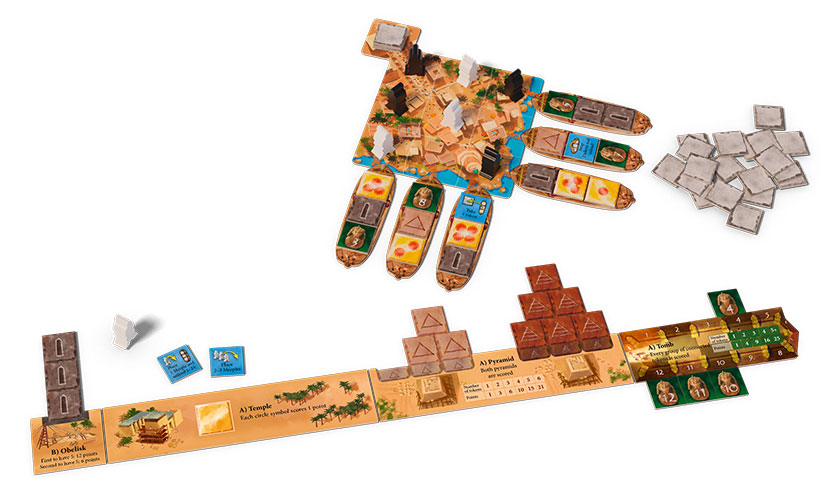Imhotep came in at #24 on my top 100 boardgames list last month, one of the best games from one of my favorite designers, Phil Walker-Harding, the same mind behind Gizmos (#37), Sushi Go Party! (#87), Bärenpark (#88), Silver & Gold (#48), and Cacao (#43), although if there’s a hiccup with Imhotep it’s that the game, designed for 2 to 4 players, becomes a bit like two-player solitaire if that’s your player count. Enter this year’s Imhotep The Duel, which reimagines the base game for two players in a way that forces more interaction and requires you to think about what your opponent might be doing far more often than you would in the original game. It takes the feel and many of the main elements of Imhotep but changes some of the fundamental mechanics to make it a new game, and also condenses the playing experience to about 20 minutes. Like 7 Wonders Duel, this is how a two-player version of a larger game should relate to its original.
In Imhotep The Duel you’re still trying to unload goods from boats on to four different spaces – the obelisk, the temple, the pyramids, and the tombs – but this time, each player has their own track of four player spaces, each of which has a basic and advanced side, and all of the goods are different, whereas in the original you were just placing your stones. Each player has four meeples and will place them on a 3×3 board that has six boats along two of its adjacent sides. Each space on the grid corresponds to one space on each of two boats, one touching its column and one its row. When a boat’s row/column has at least two meeples on it, either player may choose to unload the boat, assigning the goods in those spaces to players whose meeples were in the corresponding spaces.

On a turn, you may place a meeple, unload a boat, or use a blue action tile that lets you do something more powerful. If you’ve placed your four meeples, you have to unload a boat or use an action tile that doesn’t require placing a meeple, so there will be frequent unloading throughout the game. The tiles on the boats correspond to the four spaces on each player track as well as the blue action tiles, which let you place 2 or 3 meeples in one turn, steal any single good from a boat (skipping the meeple/unloading mechanism), swap two tiles on one boat and then unload it, or place a meeple and then unload up to two boats in one turn.
The basic scoring sides for the four spaces on your track are straightforward, and three of the four have a competitive aspect to them. The obelisk tiles are all identical and score one point per tile, but the player who has the most at the end gets a six-point bonus. The pyramids come in two colors with six tiles in each color available, and each tile you place on one pyramid is worth N points, where N is the number of tiles you’ve placed there so far – so 1-2-3-4-5-6 tiles are worth 1-3-6-10-15-21 points. Since those are scarce, going for the same pyramid as your opponent limits both of your upsides. The tomb tiles are numbered 1-12, each unique, and you score for contiguous groups of tiles, with those values also scaling up with a maximum of 5 adjacent tiles for 25 points. Groups of 6+ also score at 25, so your opponent might try to give you a tile that joins two of your groups and takes potential points away. Only the temple tiles are noncompetitive – each has 1 to 4 dots on it representing its point value.
The ‘B’ sides introduce a bit more competition and strategy but are still pretty simple to grasp. The obelisk gives a bonus of 12 points to the first player to get to 5 tiles and 6 points to the second, but if one player gets 10 tiles they get all 18 points. The temple switches from one point per dot to points for collecting sets of tiles with 1, 2, 3, and 4 dots. The pyramids now only score for your pyramid with fewer tiles on it, and you lose 6 points if you have 0 tiles on either pyramid. The tombs now score 4 points per group of tiles, with one tile still constituting a group, so you want to separate your tiles as much as possible (e.g., only getting odd-numbered tiles).
When there are no longer enough tiles in the supply to refill a boat a player has unloaded, that boat is removed from the game. The game ends when the fifth boat has been unloaded, so there will always be one boat (with three tiles on it) that isn’t unloaded. Players add up their points from the four scoring areas, then gain one point per unused blue action tile and one per meeple still on the 3×3 board. I timed my last game, against a player who’d never played this version before, and we finished in just under 20 minutes. It’s fun, portable, and fast to set up & play, and I’ll put it among my top ten two-player games when I next update that list. I got it for $13 on sale but it’s still just $19 on amazon.